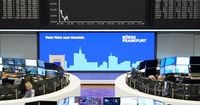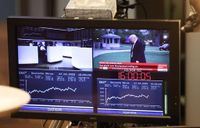In a dramatic shift in global financial dynamics, European markets are experiencing a resurgence as the repercussions of former President Donald Trump’s trade policies continue to reshape the landscape of international trade. Investors are increasingly turning their attention to Europe, where the euro has reached its strongest value in three years, and German bonds have outperformed U.S. Treasuries in a manner not seen before. This shift is indicative of a broader trend where European financial assets are gaining traction, even as the U.S. grapples with the fallout from escalating trade tensions.
According to a report from Bloomberg published on April 16, 2025, Trump’s efforts to redefine global trade and security have significantly undermined America’s long-standing dominance in these areas. The euro is currently the strongest it has been in three years, reflecting growing confidence in the European economy. Additionally, German bonds have recently outperformed Treasuries by a historic margin, signaling a notable shift in investor sentiment.
Despite the challenges posed by the ongoing trade war, European shares have displayed resilience that American stocks have struggled to match. The pan-European STOXX 600 index saw a slight decline of 0.2% on April 16, but this was largely attributed to pressures from semiconductor-related stocks. Notably, shares in ASML, a leading chip-making equipment supplier, dropped 5.2% after the company warned that U.S. tariffs were increasing uncertainty around its outlook for 2025 and 2026.
In the U.S., the markets reacted to Trump’s recent hints at potential temporary tariff exemptions for the auto industry, particularly affecting countries like Mexico and Canada. However, this optimism was tempered by news of the U.S. initiating investigations into imports of pharmaceuticals and semiconductors, as part of a broader strategy to impose tariffs. On April 15, the Dow Jones Industrial Average fell by 155.83 points (0.4%) to close at 40,368.96, while the S&P 500 dipped 9.34 points (0.2%) to 5,396.63, and the Nasdaq edged down 8.32 points (0.1%) to 16,823.17.
The economic landscape in the U.S. is showing signs of strain as well. The Labor Department reported that import prices slipped by 0.1% in March 2025, following a downwardly revised increase of 0.2% in February. Meanwhile, export prices remained flat, indicating a stagnation in trade dynamics that could further complicate recovery efforts.
As the U.S. grapples with these challenges, the European markets are not without their own hurdles. The semiconductor sector has been particularly hard hit by the trade war, with analysts predicting a 3% drop in first-quarter profits for European companies, a deeper decline than the previously expected 2.2%. This uncertainty is compounded by the ongoing geopolitical tensions, particularly between the U.S. and China, which have led to fresh curbs on Nvidia chip exports to China.
Despite these challenges, there are glimmers of hope in the European economy. China's economy grew faster than expected in the first quarter of 2025, driven by robust consumer spending and industrial production, which could bode well for European exporters. Gold prices have also surged, trading near $3,300 per ounce, reflecting a flight to safety amid the tumultuous market conditions.
In the bond market, treasuries saw continued strength following a rebound, with the yield on the benchmark ten-year note falling by 4.1 basis points to 4.32%. This shift indicates a flight to safety among investors, as they seek stability amid the uncertainty caused by trade tensions.
As European markets continue to attract investors, the upcoming earnings season will be crucial in assessing the full impact of the ongoing trade war. With corporate earnings expectations already lowered, analysts will be closely monitoring how companies navigate these turbulent waters.
In conclusion, the shifting tides of global finance are palpable as Europe emerges as a potential safe haven for investors amidst the chaos of U.S. trade policies. While the euro strengthens and European bonds gain favor, the repercussions of the trade war continue to loom large, creating a complex and evolving landscape for investors on both sides of the Atlantic.






